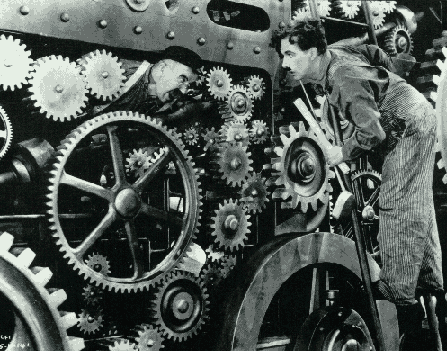"I want you on the Swansea lathe today."
— Boss of the Christ figure in "The Machinist" (2004)
Related material in this journal—
Dylan Thomas and Modern Times—
"I want you on the Swansea lathe today."
— Boss of the Christ figure in "The Machinist" (2004)
Related material in this journal—
Dylan Thomas and Modern Times—
Where Entertainment Is God continues...
New York Lottery today— Midday 710, Evening 563.
This suggeests a scientific note from the date 7/10 (2009) and the page number 563 from Dec. 29—
Bulletin of the American Mathematical Society , October 2002, p. 563:
“To produce decorations for their weaving, pottery, and other objects, early artists experimented with symmetries and repeating patterns. Later the study of symmetries of patterns led to tilings, group theory, crystallography, finite geometries, and in modern times to security codes and digital picture compactifications. Early artists also explored various methods of representing existing objects and living things. These explorations led to… [among other things] computer-generated movies (for example, Toy Story ).”
– David W. Henderson, Cornell University
For a different perspective on Toy Story , see the Dec. 29 post.
Other entertainments — The novel Infinite Jest and two versions of "Heeere's Johnny !" —
From Stanley Kubrick and from today's New York Times :

See also All Things Shining and the lottery theology of Jorge Luis Borges.
Part I: True
Bulletin of the American Mathematical Society , October 2002, page 563 —
“… the study of symmetries of patterns led to… finite geometries….”
– David W. Henderson, Cornell University
This statement may be misleading, if not (see Part II below) actually false. In truth, finite geometries appear to have first arisen from Fano's research on axiom systems. See The Axioms of Projective Geometry by Alfred North Whitehead, Cambridge University Press, 1906, page 13.
Part II: Grid
For the story of how symmetries of patterns later did lead to finite geometries, see the diamond theorem.
From the Bulletin of the American Mathematical Society , October 2002, p. 563:
“To produce decorations for their weaving, pottery, and other objects, early artists experimented with symmetries and repeating patterns. Later the study of symmetries of patterns led to tilings, group theory, crystallography, finite geometries, and in modern times to security codes and digital picture compactifications. Early artists also explored various methods of representing existing objects and living things. These explorations led to… [among other things] computer-generated movies (for example, Toy Story ).”
– David W. Henderson, Cornell University
THE SOURCE —

From the weblog The Ghost Light on Christmas Day, 2010 —
Tribute
“Un train peut encacher un autre.“
Modern Times:

From the Bulletin of the American Mathematical Society, October 2002, p. 563:
“To produce decorations for their weaving, pottery, and other objects, early artists experimented with symmetries and repeating patterns. Later the study of symmetries of patterns led to tilings, group theory, crystallography, finite geometries, and in modern times to security codes and digital picture compactifications. Early artists also explored various methods of representing existing objects and living things. These explorations led to…. [among other things] computer-generated movies (for example, Toy Story).”
— David W. Henderson, Cornell University
From an earlier Log24.net note:
John Frankenheimer’s “The Train” —

Und was für ein Bild des Christentums
ist dabei herausgekommen?
Modern Times

ART WARS September 27, 2002:
From the Bulletin of the American Mathematical Society, October 2002, p. 563:
"To produce decorations for their weaving, pottery, and other objects, early artists experimented with symmetries and repeating patterns. Later the study of symmetries of patterns led to tilings, group theory, crystallography, finite geometries, and in modern times to security codes and digital picture compactifications. Early artists also explored various methods of representing existing objects and living things. These explorations led to…. [among other things] computer-generated movies (for example, Toy Story)."
— David W. Henderson, Cornell University
From an earlier log24.net note:
|
ART WARS September 12, 2002
John Frankenheimer's film "The Train" —
Und was für ein Bild des Christentums |
From Today in Science History:
Locomotion No. 1
| [On September 27] 1825, the first locomotive to haul a passenger train was operated by George Stephenson's Stockton & Darlington's line in England. The engine "Locomotion No. 1" pulled 34 wagons and 1 solitary coach…. This epic journey was the launchpad for the development of the railways…. |
From Inventors World Magazine:
Some inventions enjoyed no single moment of birth. For the steam engine or the motion-picture, the birth-process was, on close examination, a gradual series of steps. To quote Robert Stevenson: 'The Locomotive is not the invention of one man, but a nation of mechanical engineers.' George Stevenson (no relation) probably built the first decent, workable steam engines… Likewise the motion camera developed into cinema through a line of inventors including Prince, Edison and the Lumière brothers, with others fighting for patents. No consensus exists that one of these was its inventor. The first public display was achieved by the Lumière brothers in Paris.
From my log24.net note of Friday, Sept. 13th:
"Dante compares their dance and song to God’s bride on earth, the Church, when she answers the morning bells to rise from bed and 'woo with matins song her Bridegroom's love.' Some critics consider this passage the most 'spiritually erotic' of all the one hundred cantos of the Comedy."
From my log24.net note of September 12:

Everybody's doin'
a brand new dance now…
Powered by WordPress